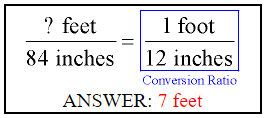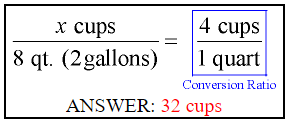The English System of Measurement
The English system of measurement grew out of the creative way that people measured for themselves. Familiar objects and parts of the body were used as measuring devices. For example, people measured shorter distances on the ground with their feet.
They measured longer distances by their paces (a “mile” was a thousand paces). They measured capacities with common household items such as cups, pails, and baskets. The word gallon comes from an old name for a pail.
Unfortunately, these creative measuring devices allowed for different measurements to be obtained when different people measured the same items. Eventually, a standard was set so that all measurements represented the same amount for everyone.

Conversions
Sometimes you need to convert from one unit of measure to another similar unit. How many inches are in 3 feet? How many ounces in 5 pounds?
Proportions will help you make conversions when working with measurements.
Create a unit conversion ratio, which is always equal to 1:

Example 1: Convert 84 inches to feet.
A proportion can be set up using the appropriate conversion ratio. In a proportion the product of the means equals the product of the extremes. Use this “cross multipy” concept to find the answer.

Example 2: Find the number of cups in two gallons.
There is no stated conversion for cups to gallons, so we have to be a bit more creative. Since there are 4 cups in 1 quart, and 4 quarts in 1 gallon, we can set up the conversion ratio based on “quarts”. Two gallons is 8 quarts.

Example 3: Convert 16 tons to pounds.
Set up the conversion ratio and solve for the missing value.
